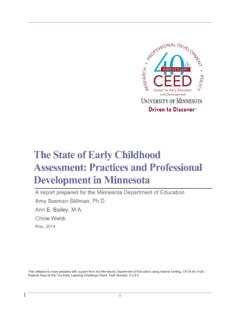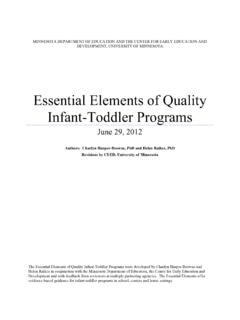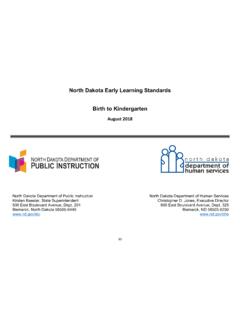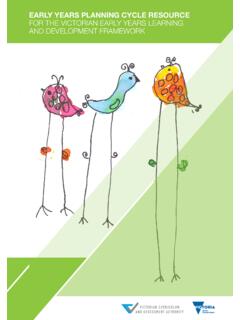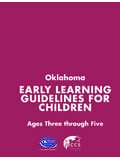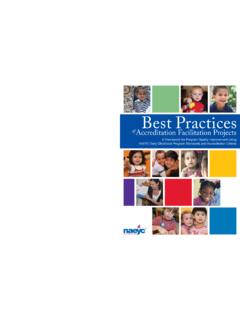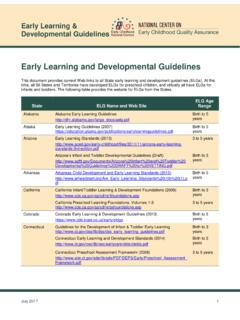Transcription of Early Childhood Indicators of Progress: Minnesota's Early ...
1 EARLYCHILDHOODINDICATORSOF Progress: minnesota s Early learning StandardsA framework for understanding and communicating a common setof developmentally appropriate expectations for children in the preschool period of ages three tofive, presented within a context ofshared responsibility and accountability for helping childrenmeet these expectationsFAMILY MEMBERS TEACHERS AND CAREGIVERS COMMUNITY MEMBERS POLICYMAKERS2005 BACKGROUND AND ACKNOWLEDGEMENTSThe Early Childhood Indicators of progress : Minnesota's Early learning standards (2005) is a projectof the minnesota Department of Education (MDE) and the minnesota Department of Human Services(DHS).
2 The first edition was printed under the title minnesota Early Childhood Indicators of progress : AResource Guidein 2000 by the former minnesota Department of Children, Families & learning . AnEarly Childhood Indicators of progress Task Force that included Early Childhood practitioners andmembers of the minnesota Association for the Education of Young Children (MNAEYC) and the Min-nesota Association of Early Childhood Teacher Educators (MAECTE) developed it. It was widelyreviewed at that time by many individuals representing a diversity of Early Childhood education andcare 2005 revision was drafted by an interagency committee working with Early Childhood consultantGail Roberts and included.
3 Lisa Backer, MDE, Early Childhood Special EducationKaren Carlson, MDE, Early learning ServicesBetty Cooke, MDE, Early Childhood Education/ Early Childhood Family EducationJoAnn Enos, DHS, Child Development ServicesBarbara O'Sullivan, MDE, Early Childhood Education/School ReadinessDebbykay Peterson, MDE, Early Childhood Screening/KindergartenSandy Simar, MDE, Head Start CollaborationDeb Swenson-Klatt, DHS, Child Development ServicesNancy Wallace, Early Childhood education consultant and author of the first edition/St. Francis PublicSchoolsThe following members of the original Early Childhood Indicators of progress Task Force received therevised draft to review:Sharon Bahe, St.
4 Paul Public SchoolsSandra Benson, St. Francis Public SchoolsDenise Bryant, Child CareMarilee Christensen-Adams, Anoka-Hennepin Public SchoolsLois Engstrom, MDE, RetiredLinda Frost, Mankato Public SchoolsLynn Galle, University of minnesota , Twin CitiesDan Gartrell, Bemidji State UniversitySharon Henry-Blythe, Greater Minneapolis Day Care AssociationMary Jo Hensel, Lake Crystal-Wellcome Memorial School DistrictGretchen Irvine, Augsburg CollegeMargie McMahon, White Bear Lake Public SchoolsNancy Penn, St. Peter Public SchoolsAnita Segador Beaton, Metropolitan State UniversityMelissa Shamblott, St.
5 Paul Public SchoolsKathy Simonson, Elk River Public SchoolsVicki Thrasher Cronin, Ready4 KThe revised draft was also provided electronically for review and feedback on statewide list servesreaching hundreds of administrators, teachers, and caregivers in the following minnesota Early child-hood education and care programs:Child Care Centers/Family Child Care/Tribal Child CareChild Care Resource and Referral Early Childhood Family EducationEarly Childhood ScreeningEarly Childhood Special Education/Part CHead StartSchool ReadinessMembers of MNAEYC and MAECTE also reviewed it, and MNAEYC passed a resolution in support of was carefully reviewed by the interagency committee and incorporated into this final support and contributions of members from the Early Childhood education associations.
6 Staff fromearly Childhood education and care programs, and many others who reviewed and provided feedbackon this document are gratefully progress : minnesota s Early learning StandardsIntroduction1 Potential Uses4 Organization and Structure of Document10 Early Childhood Indicators of progress Domain Framework11 Social and Emotional Development13 Emotional Development14 Self-Concept16 Social Competence and Relationships18 Approaches to Learning19 Curiosity20 Risk-Taking22 Imagination and Invention24 Persistence26 Reflection and Interpretation28 Language and Literacy Development29 Listening30 Speaking32 Emergent Reading34 Emergent Writing36 Creativity and the Arts37
7 Creating38 Responding40 Evaluating42 Cognitive Development43 Mathematical and Logical Thinking44 Scientific Thinking and Problem-Solving46 Social Systems Understanding48 Physical and Motor Development49 Gross Motor Development50 Fine Motor Development52 Physical Health and Well-Being54 Early Childhood Indicators of progress : minnesota s Early learning Standards55 Reference List58 Additional Resources60 TABLE OF CONTENTSEARLYCHILDHOODINDICATORSOF progress : minnesota s Early learning StandardsA large and growing body of researchsupports the critical relationshipbetween Early Childhood experiencesand successful learning responsibility for providing sup-port systems and resources thatresult in positive outcomes for youngchildren is a shared one.
8 Families, Early Childhood teachers and care-givers, community members, and pol-icymakers all contribute to the well-being of Early Childhood Indicators ofProgressdocument recognizes theimportance of this shared responsibili-ty and accountability in order toachieve positive outcomes for chil-dren. This document stresses theimportance of collective efforts amongfamilies, Early Childhood educationand care, communities, and policy-makers in supporting the learning anddevelopment of children. The effortsof each and every one of thesegroups are vital in the process ofdeveloping healthy, well-functioningchildren.
9 The primary purpose of this docu-ment is to provide a framework forunderstanding and communicating acommon set of developmentallyappropriate expectations for youngchildren within a context of sharedresponsibility and accountability forhelping children meet these document was developed withfive goals in mind:1. To increase understanding of all areas of a child's development and to recommend strategies for supporting optimum To expand understanding of the multiple influences on the education and life success of young To support families by providing examples of strategies that facilitate and enhance children's To provide teachers, caregivers, and administrators in Early Childhood education and care programs and settings with a common conceptual framework and guidelines for planning curriculum, instruction.
10 And assessment of young To provide a resource for community members and policymakers to use in assessing the impact of current policies and resources on the optimal development of young goals are consistent withreports from several national groupsstudying the development of state-level Early learning standards (NAEYC & NAECS/SDE, 2002; Scott-Little, Kagan, & Frelow, 2003a;Shore, Bodrova, & Leong, 2004). Early learning standards expressshared expectations for young chil-dren's learning and provide a com-mon language for measuringprogress toward achieving thesegoals (Kendall, 2003; Kagan & Scott-Little, 2004).
